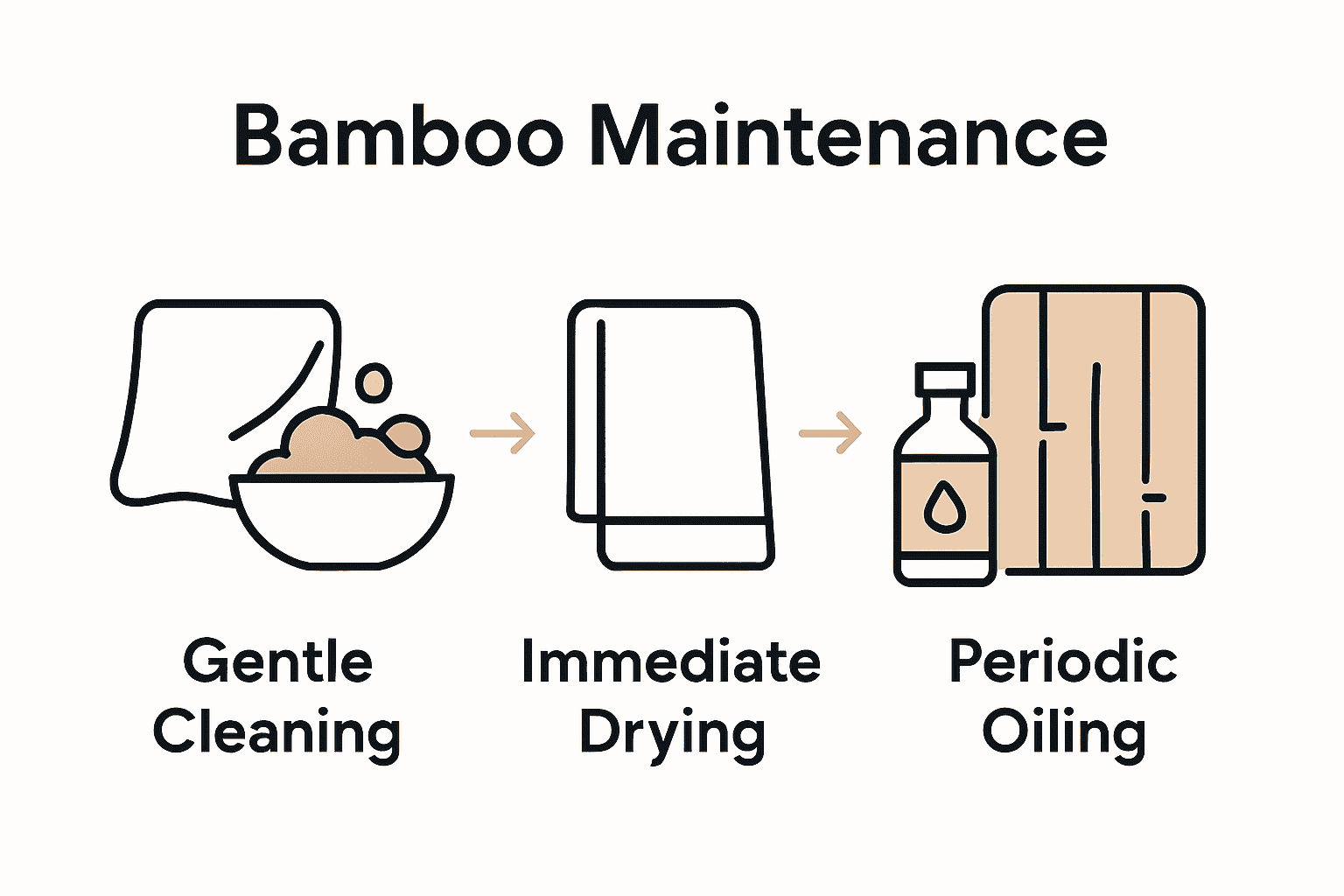Your Cart is Empty
Free Standard Shipping for Contiguous U.S. Orders!
Free Standard Shipping for Contiguous U.S. Orders!
Catalog

Essential Bamboo Product Maintenance Tips for Lasting Beauty
November 20, 2025 8 min read
Nearly 30 percent of american households now own bamboo kitchenware or decor, yet many struggle to keep these beautiful pieces looking their best. Bamboo’s natural appeal makes it a popular choice, but it requires special care to prevent damage from water or harsh cleaners. Understanding the right steps for bamboo maintenance can help protect both your investment and the stylish look of your home. This guide shows how simple habits can keep your bamboo items looking new and lasting longer.
Table of Contents
- Step 1: Prepare Cleaning Supplies For Bamboo Care
- Step 2: Clean Surfaces Using The Right Techniques
- Step 3: Dry And Protect Bamboo From Moisture
- Step 4: Apply Natural Oils To Enhance Longevity
- Step 5: Inspect And Address Wear Or Damage
Quick Summary
| Essential Insight | Explanation |
|---|---|
| 1. Prepare Gentle Cleaning Supplies | Use mild soap, warm water, and soft microfiber cloths to clean bamboo without damaging its surface. |
| 2. Clean Immediately and Thoroughly | Wipe bamboo products dry right after use with gentle circular motions to prevent moisture damage. |
| 3. Regularly Inspect for Damage | Check bamboo items every few months for signs of wear or moisture effects to prevent significant issues. |
| 4. Apply Natural Oils Periodically | Use mineral oil to protect the bamboo, enhancing its appearance and longevity while preventing moisture damage. |
| 5. Store in Dry, Well-Ventilated Areas | To avoid mold and deformation, keep bamboo items stored in dry environments and away from direct moisture. |
Step 1: Prepare Cleaning Supplies for Bamboo Care
Getting ready to clean and maintain your bamboo products starts with assembling the right cleaning supplies. Before diving into the cleaning process, you will want to gather gentle cleaning materials that will protect the natural beauty and integrity of your bamboo items.
According to amnow, the first critical step is preparing warm water for hand washing. You will need a few key supplies: soft microfiber cloths, mild dish soap, warm water, and a clean drying towel. Avoid harsh chemical cleaners or abrasive scrubbers that could damage the delicate bamboo surface. Select a soft cloth that will not scratch or create micro abrasions on the wood.
One helpful tip is to have separate cloths for washing and drying to prevent cross contamination. Keep your cleaning supplies organized in a dedicated space near your sink or cleaning area so you can quickly access everything you need. Soft cotton or microfiber cloths work best because they are gentle and highly absorbent without leaving lint or residue on your bamboo products.
By carefully preparing your cleaning supplies, you will be ready to keep your bamboo items looking pristine and well maintained for years to come. Your next step will involve understanding the specific washing techniques for your unique bamboo product.

For more comprehensive guidance, check out our guide on bamboo product care.
Step 2: Clean Surfaces Using the Right Techniques
Now that you have assembled your cleaning supplies, it is time to learn the proper techniques for cleaning your bamboo products. The goal is to maintain the beautiful surface and prevent any potential damage during the cleaning process.
According to amnow, you should clean bamboo products immediately after use and always wipe them dry with a soft cloth. Use warm water and a soft cloth while avoiding hard bristles or steel wool that could create scratches. Roewer Rueb recommends that superficial discoloration can be removed by washing with a sponge, but cautions against using high-pressure cleaners or steam jets that might harm the surface.
When cleaning, use gentle circular motions with your soft cloth and mild dish soap. Rinse thoroughly with warm water to remove all soap residue. Pay special attention to any textured areas or crevices where dirt might accumulate. After washing, immediately dry the surface with a clean microfiber cloth to prevent water spots or potential moisture damage.
A pro tip is to test your cleaning method on a small, inconspicuous area first to ensure you do not accidentally damage the bamboo surface. Always work with the grain of the wood and avoid scrubbing too hard. Your careful approach will help preserve the natural beauty and integrity of your bamboo products.
Learn more about maintaining your bamboo items in our comprehensive care guide.
Step 3: Dry and Protect Bamboo from Moisture
After cleaning your bamboo products, proper drying and moisture protection become crucial to maintaining their long term quality and appearance. Your goal is to prevent water damage and potential deterioration of the natural bamboo material.
According to amnow, you should never allow bamboo to soak in water, as this can cause the material to separate. Always store bamboo items in a dry, well-ventilated space and avoid stacking them while they are still wet or damp. Vantide Bamboo warns that moisture can lead to serious issues like mold, rot, and structural weakening over time.
To effectively dry your bamboo products, use a clean microfiber cloth to immediately remove all water droplets after washing. Place the item in a well-ventilated area away from direct sunlight or heat sources that might cause cracking. If you live in a humid environment, consider using a small fan to help speed up the drying process and prevent moisture buildup.
One critical tip is to inspect your bamboo items regularly for any signs of moisture damage. After humid days or potential water exposure, take a moment to wipe down the surface and check for any discoloration or soft spots that might indicate potential moisture problems. Quick action can prevent long term damage and extend the life of your bamboo products.
Learn more about maintaining durable bamboo home products in our comprehensive guide.
Step 4: Apply Natural Oils to Enhance Longevity
Maintaining the beauty and durability of your bamboo products requires more than just cleaning and drying. Applying natural oils periodically can help protect the surface and preserve its original luster and quality.
According to amnow, you should periodically use a soft cloth to wipe down your bamboo products with mineral oil. This simple maintenance step helps keep the bamboo looking new and provides a protective layer against environmental wear and potential moisture damage.
To apply the oil, start by ensuring your bamboo item is completely clean and dry. Use a soft lint-free cloth and apply a small amount of food-grade mineral oil or specialized bamboo conditioning oil. Gently rub the oil into the surface using circular motions, working with the grain of the wood. Be careful not to oversaturate the surface; a thin, even layer is all you need to protect and nourish the bamboo.
One important tip is to perform this oiling process in a well-ventilated area and allow the bamboo to absorb the oil for about 15 to 20 minutes before wiping away any excess with a clean cloth. This will help prevent any sticky residue and ensure a smooth, protective finish. Regular oiling every few months can significantly extend the life of your bamboo products and keep them looking beautiful.

Discover more about maintaining durable bamboo home products in our comprehensive guide.
Step 5: Inspect and Address Wear or Damage
Maintaining the pristine condition of your bamboo products requires regular and careful inspection. Proactively identifying potential issues can help you prevent minor problems from becoming major repairs and extend the life of your bamboo items.
Vantide Bamboo emphasizes the importance of regularly inspecting bamboo items, particularly after environmental events like heavy rain. This careful examination helps reduce potential risks such as fungal growth and early signs of structural weakness. Roewer Rueb suggests that consistent care prevents discoloration and maintains the attractive appearance of bamboo products.
When inspecting your bamboo items, look for specific signs of wear or damage. Check for changes in color, soft or splintering areas, unusual texture variations, or small cracks. Pay special attention to areas that experience more stress or frequent use. Run your fingers gently along the surface to detect any subtle changes that might not be immediately visible. If you notice superficial discoloration, you can often remove it by carefully washing with a soft sponge.
One critical tip is to create a regular inspection schedule. Set a reminder every few months to thoroughly examine your bamboo products. If you discover minor damage, address it immediately to prevent further deterioration. For small scratches, you might apply a thin layer of mineral oil. For more significant damage, consult a professional or consider replacing the item to maintain the highest quality and aesthetic standards.
Learn more about maintaining durable bamboo home products in our comprehensive guide.
Keep Your Bamboo Products Beautiful with Cozee Bay Solutions
Maintaining the natural beauty and durability of bamboo products can be challenging without the right care and tools. This article highlights how crucial gentle cleaning, proper drying, and periodic oiling are to preserving bamboo’s lasting appeal. If you want to avoid cracks, discoloration, and moisture damage, having high-quality bamboo accessories that complement your maintenance routine makes all the difference. Cozee Bay specializes in eco-friendly bamboo products designed to fit seamlessly into your home or commercial space while supporting your bamboo care efforts.
Discover our sleek and functional Bamboo Paper Towel Dispenser- A Sleek Look Home or Office that adds style and sustainability to your cleaning process.

Elevate your bamboo care with Cozee Bay today. Shop thoughtfully crafted bamboo dispensers, accessories, and organizers that protect your products while enhancing your environment. Don’t wait to preserve your bamboo’s timeless beauty. Visit Cozee Bay now to explore a wide selection crafted for durable, stylish, and eco-conscious living. For added convenience, check out our selection of Paper Towel Dispensers - Accessories | Cozee Bay® and the Plastic Wrap Dispenser With Cutter | Cozee Bay® to complete your sustainable kitchen and home setup.
Frequently Asked Questions
How should I clean my bamboo products?
To clean bamboo products, use warm water and mild dish soap along with a soft microfiber cloth. Gently wipe the surface in circular motions and avoid abrasive materials to prevent scratches.
What is the best way to dry bamboo items after washing?
After washing, immediately use a clean microfiber cloth to remove excess moisture and place the bamboo item in a well-ventilated area away from direct sunlight. This helps prevent water spots and potential damage.
How often should I apply oil to my bamboo products?
You should apply natural oils every few months to maintain the beauty and durability of your bamboo. Use a thin, even layer of mineral oil and allow it to absorb for about 15 to 20 minutes for best results.
What signs of damage should I watch for when inspecting bamboo?
Look for color changes, soft or splintering areas, and unusual textures during your inspection. Regularly checking for these signs can help you catch minor issues before they become major repairs.
Can I use any type of cleaner for bamboo?
No, it’s important to avoid harsh chemicals and abrasive cleaners that can damage bamboo. Stick to mild dish soap and warm water to keep your bamboo products in their best condition.
How can I protect my bamboo items from moisture damage?
Store bamboo items in a dry, well-ventilated area and avoid letting them soak in water. Regularly inspect for moisture signs and dry them promptly after washing to prevent mold and rot.
Recommended
- Cozee Bay - Bamboo Product Care Tips for Lasting Beauty and Durability
- Cozee Bay - How to Maintain Bamboo Organizers for Lasting Durability
- Cozee Bay - Complete Guide to Durable Bamboo Home Products
- Cozee Bay - Why Choose Bamboo Home Products: Sustainable Living Explained
- 7 Essential Tips for Better 2a Hair Care and Growth | MyHair
Leave a comment
Comments will be approved before showing up.
Subscribe
Sign up to get the latest on sales, new releases and more …

